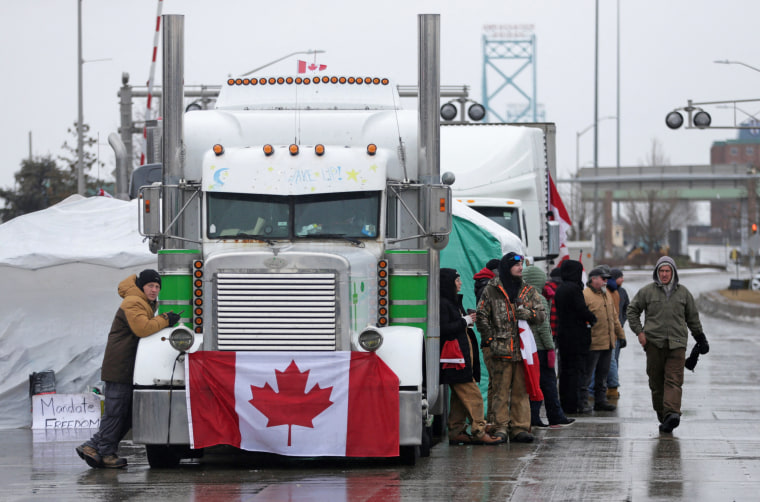Small grocery stores in Canada that depend on the United States for all kinds of foods, from fruits and vegetables to cereal, are starting to feel the strain of the trucker protest that has led to the partial blockade of a major border crossing between Canada and the United States. Since these independent grocers tend to have fewer resources and smaller budgets, they're more affected by changes in price, which increase as supply dwindles. They're also often in suburban, rural or Indigenous communities in Canada where they serve as one of the few or only sources of groceries.
“Independent grocers tend to be in communities where many times there’s not a chain retailer, they’re the only game in town, so when there are supply chain issues, it becomes more acute,” said Gary Sands, senior vice president of the Canadian Federation of Independent Grocers, or CFIG. “It can quickly become an issue of food security.”
The trucker convoy blockade on the Ambassador Bridge is exacerbating an already tenuous situation for the roughly 6,900 independent grocers that exist across Canada, according to the CFIG. It’s yet another blow to an industry already under strain from the ongoing pandemic and broader supply chain issues.
The situation is still changing quickly for both grocers and customers as the protest continues against a Covid-19 vaccine mandate imposed by Prime Minister Justin Trudeau for truckers entering the country from the United States.
“Roughly 25 percent of all food and consumer products, as well as packaging and ingredients, are shipped by trucks across the Ambassador Bridge alone and the current demonstrations could inevitably lead to plant shutdowns, potential layoffs, reduced on-shelf availability and increased pricing for many products like fruits and vegetables,” said Michelle Wasylyshen, national spokeswoman for the Retail Council of Canada.
“Canada’s critical trade and transportation infrastructure is vital to the lives and livelihood of all Canadians,” she said, and the current protests are “likely to reduce choices for Canadian consumers and drive costs up for families.”
Fruits and vegetables have been harder for Canadian grocers to get. But soups, spices and cereal, which were already hurt by factory worker strikes in the U.S., have also become more scarce.

The timing of the protest highlights an additional vulnerability for Canadians, in particular those in the most remote areas, because they rely heavily on imported fruits and vegetables.
“In Canada, in the winter we don’t grow a lot of fruits and vegetables. So 40 to 50 percent of the produce we get here in Ontario for national distribution comes [in that way],” Sands said. “We’re already seeing shortages and late deliveries of stuff from the States that we depend on and expect. These are things with a finite shelf life in many cases.”
The greater the delays, the more products will sit, raising concerns about spoilage and waste. All of these factors could compound and lead to increased costs for grocers, which would inevitably affect customers. Already small grocers are beginning to grapple with this.
Giancarlo Trimarchi co-owns four Vince’s Market grocery stores in Ontario. He said he’s slightly reassured by the fact that there are other points of entry for goods to get into Canada. However, he noted that if the protest persists or other entry points become strained, he doesn’t have much of a contingency plan in place.
“The risk as an independent is that we get treated as the bottom of the barrel. Bigger suppliers have budget and power that we don’t, which could affect our ability to get products,” Trimarchi said. “For independent grocers, a lot of us differentiate on our fresh products, 37 percent of our store sales come from produce. Plus, the core of our business, about 80 percent, is around fresh departments such as bread, meat, produce, which have a short shelf-life.”
He said the situation is putting even more pressure on his most vulnerable customers and forcing many to choose between health and cost as supply issues lead to price increases.
“We’re trying to be as reasonable or fair with our pricing but grocery stores like us don’t make a lot so there’s not a lot of margin to give up,” he said. “Our clientele is mixed, some can adjust but others suffer. Processed foods become so much more appealing when produce is hit with higher prices, which most of the time disadvantages lower income people.”
